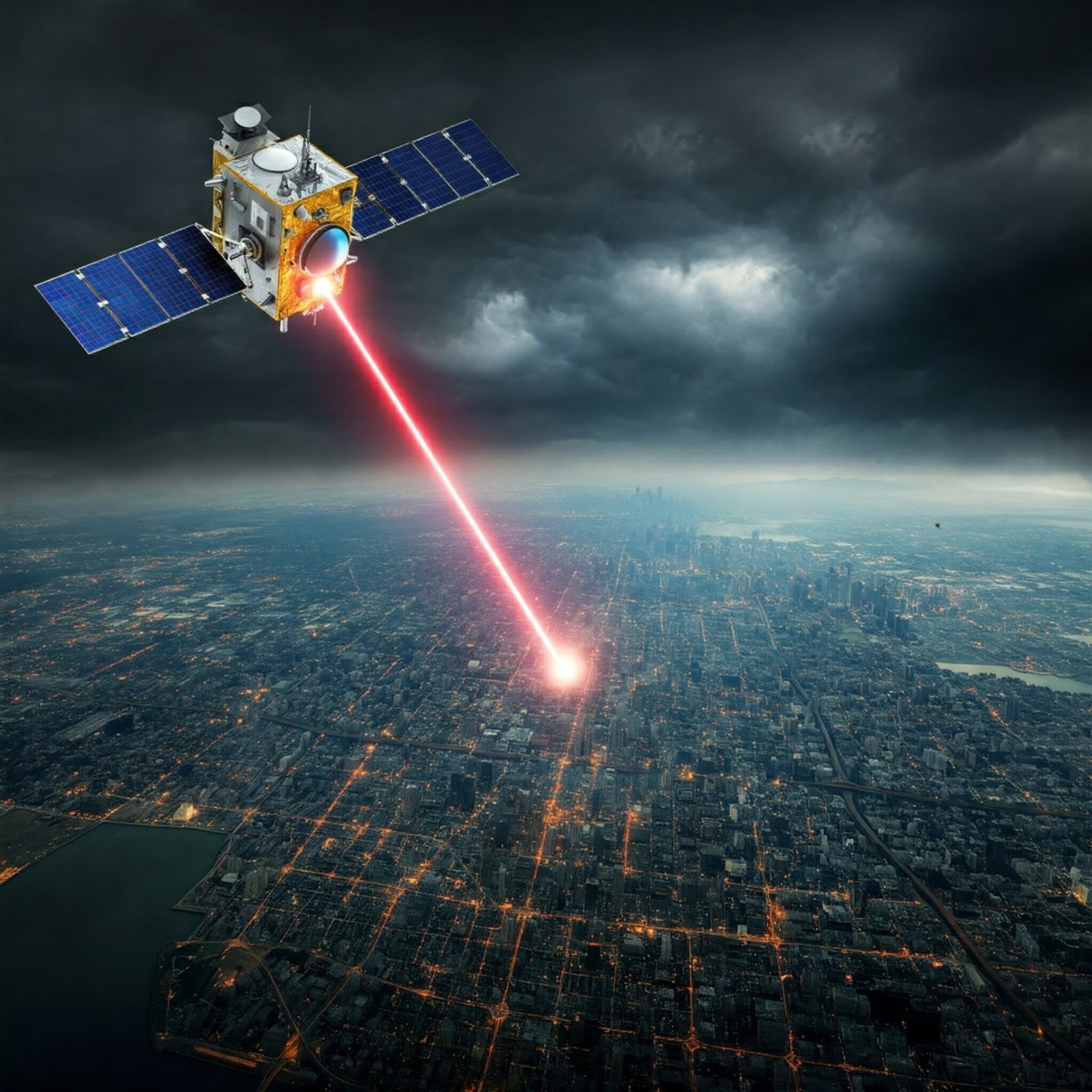Space used to be all about exploration and science. Astronauts and scientists were the heroes, pushing the boundaries of human knowledge. But now, it is becoming a place where countries compete for military power. What was once a place of peaceful exploration and scientific discovery is now becoming a potential war zone.
Why is this happening? Satellites and other space-based assets are now essential for communication, navigation, and intelligence gathering. Powerful countries are realizing that controlling space is important for their national security. This has triggered a race to develop powerful space weapons.
But what exactly are these weapons? How do they work? And what happens if they are ever used? This article takes you inside the new space arms race. We will explore the different types of space weapons being developed and the potential consequences for global security. Get ready to discover a side of space exploration you never knew existed.
Advanced Weapon Systems for Space Warfare

The development of a new generation of space weapons is raising concerns about the balance of power on Earth and the stability of the space environment. These weapons include advanced systems like directed energy weapons, which can disable or destroy satellites. They also include sophisticated cyber tools designed to disrupt the essential space-based infrastructure that we depend on.
Directed Energy Weapons (DEWs)
Directed Energy Weapons (DEWs) use focused beams of energy to disable or destroy targets. These weapons have several advantages in space. They can engage targets at the speed of light and precisely target specific parts of spacecraft.
- High-Energy Lasers: High-energy lasers can blind or permanently damage sensitive optical sensors on satellites, making them useless. They can also destroy smaller satellites or critical parts of larger spacecraft.
The United States, China, and Russia are developing high-energy laser weapons for use in space.
- High-Power Microwaves (HPMs): HPMs generate intense pulses of microwave energy that can disrupt or destroy the electronic systems of satellites. They can also interfere with communication links, effectively blinding and deafening a target.
The United States, China, and Russia are at the forefront of HPM weapon development. China, in particular, has made significant strides in this area.
In January 2025, Chinese scientists achieved a breakthrough by creating a compact HPM weapon capable of generating electromagnetic pulses comparable to a nuclear explosion. Furthermore, in February 2024, China revealed an HPM weapon powered by Stirling engines, a major advance in directed-energy warfare technology.
Kinetic Energy Weapons
Kinetic energy weapons rely on physical impact to destroy or damage targets. In space warfare, these weapons usually involve launching projectiles or missiles at satellites.
- Direct-Ascent Anti-Satellite (ASAT) Weapons: Direct-ascent ASAT weapons are missiles launched from the ground to intercept and destroy satellites in orbit. Several nations have tested these weapons, demonstrating their ability to physically destroy satellites.
The United States, China, India, and Russia have all tested direct-ascent ASAT weapons.
- Co-orbital ASAT Weapons: Co-orbital ASAT weapons are launched into orbit and then maneuver close to a target satellite. These weapons can use a variety of methods to disable or destroy the target, such as robotic arms, explosives, or electronic jamming devices.
Russia has been the primary developer of co-orbital ASAT weapons. Both the Soviet Union and Russia have had dedicated co-orbital ASAT systems that use conventional explosives to destroy target satellites. China has also been actively developing co-orbital ASAT capabilities, particularly in geostationary orbit.
Electronic Warfare (EW)
Electronic warfare (EW) in space is like a high-tech battle of signals. It involves using electromagnetic energy to interfere with enemy space systems. EW techniques can target various satellite functions, including communications, navigation, and surveillance.
- Jamming Satellite Signals: Jamming involves transmitting powerful signals on the same frequency as a satellite’s communications. This effectively blocks or degrades the signal. Jamming can disrupt military communications, navigation systems, and even civilian services that rely on satellites.
- Spoofing Satellite Signals: Another EW technique is called spoofing. This involves sending fake signals that look like real satellite signals. These fake signals can trick receivers into following false information. This can cause navigation errors, misdirect military forces, or even disrupt important infrastructure. There have been incidents of GPS spoofing where ships were tricked into changing their course.
Cyber Warfare
Cyber warfare in space is like a digital attack on the systems that control satellites. These attacks can also target the ground stations that support these satellites. Cyberattacks can be used to disrupt how satellites work, steal important data, or even take control of a satellite.
- Hacking Satellites and Ground Systems: Hackers can find weaknesses in satellite software or ground station security. This allows them to gain unauthorized access and take control. They can then disrupt satellite functions, manipulate data, or even redirect the satellite to a new target.
- Concerns about Hacking: Experts are worried about how vulnerable satellites are to cyberattacks. They warn that these attacks could have disastrous consequences.
- Data Breaches: Cyberattacks can also target ground stations and data centers. These facilities store and process the information gathered by satellites. Data breaches can lead to the theft of sensitive military information, economic data, or personal information.
Hypersonic Weapons
Hypersonic weapons, while not specifically designed for space warfare, pose a significant threat to space assets. This is because of their incredible speed, ability to change direction, and power to get past traditional missile defenses.
- Hypersonic Glide Vehicles (HGVs): HGVs are launched atop ballistic missiles and then glide through the atmosphere at hypersonic speeds, Mach 5 or higher (more than five times the speed of sound). They can maneuver to evade defenses and strike targets with precision. These vehicles have the potential to target satellites in low Earth orbit.
The United States, Russia, and China are all actively developing hypersonic glide vehicles.
- Hypersonic Cruise Missiles (HCMs): HCMs are powered by air-breathing engines and also travel at hypersonic speeds within the atmosphere. While their primary targets are on Earth, HCMs with sufficient range and altitude capabilities could potentially threaten satellites.
The Race for Space Dominance

The use of space for military purposes has led to a new arms race. Each country is striving to develop and deploy advanced technologies to protect its interests in this strategically crucial domain.
United States: Maintaining a Technological Edge
The United States has always been a leader in space technology and military power. To counter new threats in space, the US is investing heavily in developing and deploying new space weapons.
Space Force
The creation of the US Space Force shows how important space has become for national security. It’s a dedicated military branch focused on space.
The Space Force has a critical mission:
- Protect US interests in space.
- Deter aggression from other countries.
- Maintain US dominance in space.
Space Systems Command (SSC)
The Space Systems Command (SSC) provides the US Space Force with the necessary tools for space operations. These tools include developing new technologies, launching satellites, maintaining existing systems, and monitoring the space environment. The SSC also collaborates with industry and international partners to ensure the US maintains space superiority.
China: A Rising Challenger
China is rapidly becoming a major player in space technology and military power. It’s even starting to challenge the world’s leading space nations for dominance in space.
People’s Liberation Army Strategic Support Force (PLASSF)
One key element of China’s space program is the People’s Liberation Army Strategic Support Force (PLASSF). This organization is like a special military branch that focuses on space, cyber, and electronic warfare. This shows how China is combining different types of technology for a stronger presence in space.
China’s Demonstrations of ASAT Capability
China has also been testing its ability to take down enemy satellites. These tests, known as ASAT tests, show that China has the power to destroy objects in space. This has caused some to worry about China’s growing ability to disrupt other countries’ use of space.
Rapid Satellite Deployment
In addition, China is launching many new satellites into space. These satellites have various purposes, such as communication, navigation, and surveillance. This demonstrates China’s commitment to expanding its presence in space.
Russia: Forging Its Own Path
Russia, a nation with a long history in space exploration, is strengthening its military presence in space. Russia is developing new space weapons to respond to what it believes are threats from other nations.
Nuclear-Powered and Nuclear-Armed ASAT Weapons
Some reports suggests that Russia is building nuclear-powered and nuclear-armed ASAT weapons to attack satellites. This raises serious worries about the possibility of a conflict in space and the potential for devastating results.
Nuclear ASAT weapons pose a serious risk. If any nation uses these weapons, the effects could be long-lasting and make space unsafe for everyone.
Counterspace Capabilities
Russia is also updating its counterspace capabilities. This includes improving its electronic warfare systems and ground-based lasers. These technologies can target enemy satellites and disrupt crucial space-based infrastructure.
Other Nations: Emerging Players in the Space Arms Race
The pursuit of military power in space is not limited to the traditional spacefaring nations. Several other countries are also developing their own space-based military capabilities, leading to a more complex and competitive environment in space.
India’s Rise as a Space Power
India has become a major player in space, showcasing its advanced capabilities in both civilian and military space technologies. In 2019, India successfully conducted an anti-satellite (ASAT) test, becoming the fourth country in the world to be able to do this, after the United States, Russia, and China. India’s space agency, ISRO, has also achieved significant milestones, including launching missions to the Moon (Chandrayaan) and Mars (Mangalyaan). It has also developed its own satellite navigation system called NavIC.
France’s Focus on Space Defense
France is another country that is increasing its investment in space defense technologies. The country is focusing on surveillance and tracking capabilities to monitor activities in space and protect its interests. France is also exploring the use of laser technologies for space-based defense systems.
Europe’s Role
Other European nations are also taking steps to improve their space defense capabilities. For example, Germany is develo ping more advanced radar systems to track objects in space. Similarly, the United Kingdom is investing in new satellite technology for navigation and communication.
Global Expansion
In addition, countries like Iran, North Korea, and Japan are also reportedly enhancing its space security and defense measures. This highlights the growing number of countries involved in the space race and the increasing importance of space-based military power.
Future of Space Warfare: Emerging Technologies

Technology is constantly evolving, and this is also true for weapons in space. New and advanced technologies are being developed that could significantly change how wars are fought in space.
- Space-Based Laser Weapons: One example is space-based laser weapons. These are high-powered lasers placed in orbit that could be used for both defense and offense. They could destroy enemy satellites, intercept ballistic missiles, or even target places on the ground.
- On-Orbit Satellite Servicing and Repair: Another area of development is on-orbit satellite servicing and repair. While this technology has peaceful uses, it could also be used for harmful purposes. For example, it could be used to damage or disable enemy satellites, disrupting important functions and creating dangerous debris in space.
- Artificial Intelligence (AI) in Space Warfare: Artificial intelligence (AI) is also playing an increasing role in space warfare. AI-powered systems could be used to make decisions without human input, identify and track targets, and coordinate complex space operations. This raises concerns about the possibility of unintended consequences and the risks of machines making life-or-death decisions in space.
It’s important to remember that AI is already used in military systems on Earth, such as in surveillance and reconnaissance tools.
- Hypersonic Defence Systems: Finally, the development of hypersonic weapons, which travel at extremely high speeds, has led to the creation of new defense systems. These hypersonic defense systems might use a combination of sensors in space, directed energy weapons, and interceptors to protect against hypersonic attacks.
Global Security and Safety Implications
Developing and deploying advanced weapons in space has serious consequences for global security and the long-term use of space.
- The Risk of Escalation and Accidental Conflict: As more nations develop and deploy space weapons, the risk of miscalculation, unintended escalation, and accidental conflict increases. The lack of clear rules of engagement and norms of behaviour in space heightens these risks.
- The Threat of Space Debris and Kessler Syndrome: Destroying satellites, whether through ASAT tests or actual combat, creates a lot of space debris. This debris can collide with other objects in space, potentially causing a chain reaction known as Kessler Syndrome. This could make entire areas of space unusable, impacting important satellite services and making future space exploration more difficult.
- The Potential for a Global Space Arms Race: The competition between major powers for dominance in space is fueling a global space arms race. This competition is leading to increased investments in counterspace capabilities and the development of new weapon technologies. This diverts resources from other important global challenges and could lead to a destabilizing arms race in space.
- The Need for International Cooperation and Arms Control: International cooperation is essential to address the growing threats to space security. It is crucial to establish clear rules of engagement, norms of behavior, and arms control agreements to prevent an uncontrolled arms race in space and reduce the risks of conflict and environmental damage. Current international laws do not adequately address the challenges of space warfare.
This highlights the urgent need for new agreements to ensure the responsible and sustainable use of space. It is important to note that there are ongoing efforts to establish international norms and standards for responsible behavior in space.
- Impact on Civilian Space Activities: The militarization of space could have a significant impact on civilian space activities. These activities include scientific research, commercial satellite operations, and space tourism. The possibility of conflict in space may discourage investment in these areas and limit the benefits of space exploration for everyone.
- Ethical Considerations: The development of space-based weapons raises important ethical questions about the militarization of space. Space has traditionally been seen as a shared resource for all humanity. There are concerns that space weapons could be used in ways that violate international law or cause excessive harm to civilians.
Conclusion
The increasing use of military force in space poses a serious challenge to the future of space exploration and global security. The development and deployment of advanced weapons threaten to turn space into a war zone, with potentially disastrous consequences for humanity.
It is crucial for the international community to work together to create a framework for the responsible and sustainable use of space. This will help ensure that space remains a place of peaceful exploration and scientific discovery for future generations.
Frequently Asked Questions (FAQs):
What are the main types of space weapons?
The main types of space weapons include directed energy weapons (lasers and high-power microwaves), kinetic energy weapons (ASAT missiles), electronic warfare systems (jammers and spoofers), cyber weapons, and hypersonic weapons.
Which countries are developing space weapons?
Many countries are developing weapons for use in space. The United States, China, and Russia are leading the way, but other countries, including India, France, Germany, and the United Kingdom, are also actively developing space weapons technology.
What are the risks of space warfare?
Space warfare poses risks of escalation of conflict and accidental clashes, especially since there are no clear rules for warfare in space. Space battles could also create large amounts of dangerous debris, potentially leading to a chain reaction that could make entire orbits unusable. This would disrupt important satellite services we rely on and make future space exploration difficult.
What can be done to prevent space warfare?
Preventing space warfare requires global cooperation. This includes establishing rules of engagement, responsible behavior, arms control agreements, and increasing trust between nations.
Articles referenced:
Your Complete Overview of Directed Energy Laser Weapons, IG Space. (Accessed: Jan 15, 2025)
Directed Energy: The Focus on Laser Weapons Intensifies, Rand Corporation, 25 Jan. 2024.
China’s Microwave Weapons Aim to Zap US Drone Swarms, Asia Times, 16 Jan. 2025.
Chinese Scientists Develop Microwave Weapon Capable of Destroying Satellites, Orbital Today, 12 Feb. 2024.
Focused on the Threat: Kinetic Energy Weapons, Part 4 of 6, Space Force, 23 Sep. 2024.
Anti-satellite weapon, Wikipedia, 7 Dec. 2024
Russia Tests Direct-Ascent Anti-Satellite Missile, Spacecom, 16 Dec. 2020.
Matter, Speed, and Understanding Hypersonic Missile Systems, SIPRI, 4 Feb. 2022.
What Does the US Space Force Do?, Space Insider Tech, 29 July 2024.
China Military Expansion, GIS Reports Online, 16 Dec. 2024.
The Creation of the PLA Strategic Support Force and Its Implications for Chinese Military Space Operations, Rand Corporation, 10 Nov. 2017.
Starlink Alert: China Testing Anti-Satellite Nuclear Weapons, Asia Times, 24 Oct. 2022.
Russia plans launching 292 communication satellites by 2027 , TASS, 3 Oct. 2024.
Mission Shakti, Wikipedia, 26 Aug. 2024.
What Is NavIC and How Does NavIC Work?, Trackobit, 23 Jul. 2024.
Implementing the French Space Defence Strategy Towards Space Control 2023, La Fondation pour la Recherche Stratégique, 29 Jun. 2023.
EU Space Strategy: Security and Defence, European Commission. (Accessed: 16 Jan. 2025)
Germany Overhauls Taurus Missile, Buys Space Surveillance Radar, Aviation Week, 19 Dec. 2024.
The Crucial Role of Lasers in Space-Based Intelligence, EOS Australia, 9 May 2024.
On-Orbit Servicing, Assembly, and Manufacturing-1, NASA, 22 Mar. 2024.
Report to Congress on Hypersonic Missile Defense 4, USNI News, 24 Jun. 2024.
Kessler Syndrome, Wikipedia, 3 Jan. 2025.
From Radar to High-Power Weapons: Microwave Tubes Power Modern Warfare, revistas.usfq.edu.ec. (Accessed: 17 Jan. 2025)
From Radar to High-Power Weapons: Microwave Tubes Power Modern Warfare, Microwave Journal, 12 Sep. 2024.
Emerging Technology Trend Cards: Directed Energy Weapons, Government of Canada. (Accessed: 17 Jan. 2025)





